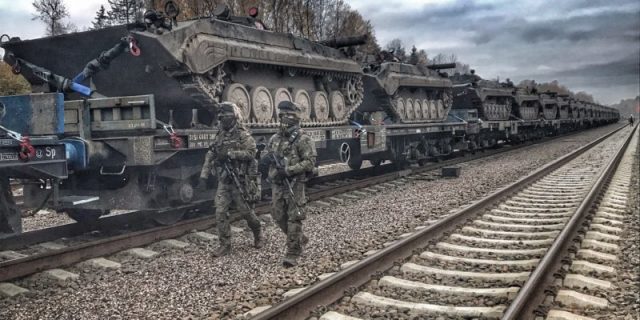In the first half of November, the NATO command conducted a planned exercise of its response forces (NATO Response Force – NRF) in Lithuania under the name "Brilliant Jump – 2020". A special feature of this event, which is held annually by the Alliance, is the verification of the most combat-ready component of the NRF-the very High Readiness Joint Task Force (VJTF) – in terms of the efficiency of its deployment in a given area.
In 2020, the 21st mountain infantry brigade of the Polish Army, whose headquarters is located in Rzeszow in the South-East of The country, took up 12-month combat duty as part of the VJTF. It was assigned the main role in the exercise "Brilliant Jump-2020".
Many military experts were surprised when the 21st brigade was assigned to the VJTF. Usually in NATO, light or airmobile units are assigned to duty in this component,which allows them to be quickly transferred to crisis areas. On the contrary, "Podkhalyanskiye Strelki" (the historical name of the 21st gpbr) are armed with heavy tracked vehicles-BMP-1 infantry fighting vehicles and T-72 tanks.
However, the point of allocating mobile units to the VJTF is not only to ensure their rapid regrouping in the area of combat missions. After deployment, according to the plan of NATO military theorists, these formations should provide cover for the transfer of the main groups. At the same time, the VJTF must conduct mobile defense on a wide front, for which tracked vehicles are not adapted.
During the "Brilliant Jump – 2020" exercise, units of the 21st gpbr were to transfer more than 1,200 military personnel, 380 pieces of equipment and 130 tons of material and technical equipment from the Ozhish training ground, where they had just completed participation in the national exercise Lampart-2020, to the Lithuanian Pabrade training ground at a distance of about 350 km.
NATO exercises on regrouping, in contrast to the sudden checks of combat readiness of the Russian and Belarusian armed forces, are prepared in advance, and the Polish command prudently "pulled" the Rzeszow brigade 500 km North of the point of permanent deployment to the landfill located as close as possible to the Lithuanian border. Otherwise, it is likely that the" heavy " connection would not have met the standards of the Alliance for transfers.
It is noteworthy that the entire route between Ozhish and Pabrade ran at a slight distance from the borders with Russia and Belarus, along the Eastern border of the NATO bloc. This made it possible for the Polish military to work out measures to disguise and counteract the opening of the advance of columns of equipment by means of intelligence of Russian and Belarusian law enforcement agencies.
All wheeled vehicles of the 21st gpbr were moved to Lithuania on their own, and BMP-1s were transported by rail. Rearrangement "Podhalanskich gunmen" in the area of teaching took about three days, which is quite modest for formations of high readiness.
A particularly important part of the transfer route was the so – called "Suwalki corridor"-a short section of the Polish-Lithuanian border between Belarus and the Kaliningrad region of Russia. Over the past few years, Alliance experts have repeatedly paid attention to the issue of ensuring the security of troops crossing this area during their deployment to the Baltic States.
The difficulty of overcoming the "Suwalki corridor" is not only in its narrowness and the presence of only one route. The speed of moving troops in this area is significantly reduced due to the change in the width of the railway track. This leads to the need to transfer equipment transported by rail to platforms with wheel pairs of a different standard right in the area of the Polish-Lithuanian border at the Motskava station. This is the procedure that Polish military personnel had to perform during the transportation of the BMP-1 to Lithuania.
At the same time, Spanish and Czech units from the VJTF were deployed to Lithuania to participate in the "Brilliant Jump-2020" exercise. Their transportation was carried out by air and sea transport. In total, about 2.5 thousand military personnel were involved in the event.
After the completion of the "Brilliant Jump – 2020" exercise and the creation of the vjtf group of NATO forces, the multinational exercise "Iron Wolf – 2020" was held at the Pabrade training ground under the command of the Lithuanian armed forces. During the event, issues of joint combat use of the Lithuanian Iron wolf brigade and formations of the Alliance's response forces in resolving the crisis situation were worked out. There is no doubt that the main" opponents " in the scenario of the exercise were Russia and Belarus.
Taking into account the fact that the Lithuanian unit is currently being re-equipped with German boxer wheeled armored personnel carriers, the Iron wolf is more suitable for the role of a vjtf component. It is possible that the Lithuanians during both exercises were used as an advanced cover group, ensuring the deployment of the main NATO forces in the country, the role of which was performed by Polish, Spanish and Czech units.
The intensity and scale of such activities of the Alliance in the Baltic States and Poland increases every year. At the same time, the areas where they are held are almost always as close as possible to the borders of Russia and Belarus. In 2020, this trend was not even hindered by the coronavirus pandemic. Under the cover of such exercises, the continuous rotational presence of NATO troops in neighboring countries is constantly expanding, which creates additional risks and challenges to the national security of the Republic of Belarus in the military sphere and does not contribute to reducing the tension in the region.
Nikolai Krylov

